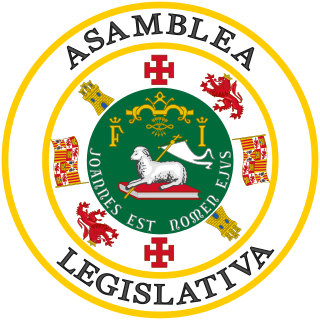
The Legislative Assembly of Puerto Rico is the territorial legislature of the Commonwealth of Puerto Rico, responsible for the legislative branch of the government of Puerto Rico. The Assembly is a bicameral legislature consisting of an upper house, the Senate normally composed of 27 senators, and the lower house, the House of Representatives normally consisting of 51 representatives. Eleven members of each house are elected at-large rather than from a specific legislative district with all members being elected for a four-year term without term limits.

General elections were held in Puerto Rico on 5 November 1996. Pedro Rosselló of the New Progressive Party (PNP) was re-elected Governor, whilst the PNP also won a majority of seats in the House of Representatives and the Senate. Voter turnout was between 80% and 82%.

The Puerto Rico statehood movement aims to make Puerto Rico a state of the United States. Puerto Rico is an unincorporated territorial possession of the United States acquired in 1898 following the Spanish–American War, making it "the oldest colony in the modern world". As of 2023, the population of Puerto Rico is 3.2 million, around half the average state population and higher than that of 19 U.S. states. Statehood is one of several competing options for the future political status of Puerto Rico, including: maintaining its current status, becoming fully independent, or becoming a freely associated state. Puerto Rico has held seven referendums on the topic since 1967, and four since 2012. They are non-binding, as the power to grant statehood lies with the US Congress.

A referendum on Public Law 81-600, granting improved self-government, was held in Puerto Rico on 4 June 1951. It was approved by 76.5% of voters.

A referendum on a new constitution was held in Puerto Rico on 3 March 1952. It was approved by 81.9% of voters. This was considered by many U.S. and Puerto Rican politicians an affirmation of the new constitution of the island as an Estado Libre Associado, or Commonwealth, as proposed by legislation in 1950 by the United States Congress after negotiation with its political leaders. Puerto Rican nationalists question the meaning of the referendum, complaining that the only alternative offered was direct U.S. rule, and no choice of independence was offered. In 1980, the Supreme Court of the United States adjudicated that as a result of this referendum of 1952, the actual territorial status was not changed at all.

A double referendum was held in Puerto Rico on 4 November 1952. Voters were asked whether they approved of amendments to the constitution regarding federal order and whether private schools should be financed with public money. Both were approved by 87.8% of voters.

A referendum on judicial reform was held in Puerto Rico on 8 November 1960. The changes were approved by 78.4% of voters.

A referendum on financial issues was held in Puerto Rico on 10 December 1961. The referendum was approved by 82.8% of voters.

A referendum on eliminating special elections to fill vacant seats in the Legislative Assembly was held in Puerto Rico on 3 November 1964, alongside the general elections. The reforms were approved by 77.5% of voters.

A referendum on the status of the island was held in Puerto Rico on 23 July 1967. Voters were given the choice between being a Commonwealth, statehood or independence. The majority of voters voted for Commonwealth status.

A referendum on the status of the island was held in Puerto Rico on 14 November 1993. Voters were given the choice between being a Commonwealth, statehood or independence. A plurality of voters voted for Commonwealth status, with a voter turnout of 73.5%.

A referendum on the political status of Puerto Rico was held on December 13, 1998. Voters were given the choice between statehood, independence, free association, being a territorial commonwealth, or none of the given options. A majority voted for the latter, with a turnout of 71.3%.

A constitutional referendum was held in Puerto Rico on 8 December 1991. The amendments would guarantee:

A constitutional referendum was held in Puerto Rico on 6 November 1994. Voters were asked whether they approved of two amendments, one to eliminate the absolute right to bail and the other to increase the number of Supreme Court judges. Both were rejected by 54% of voters, with a turnout of 62.2%.

General elections were held in Puerto Rico on November 8, 1960. Luis Muñoz Marín of the Popular Democratic Party (PPD) was re-elected as governor, whilst the PPD's Antonio Fernós Isern was re-elected as Resident Commissioner. Voter turnout was 85%.

General elections were held in Puerto Rico on November 3, 1964. Roberto Sánchez Vilella of the Popular Democratic Party (PPD) was elected Governor, whilst the PPD's Santiago Polanco-Abreu was elected Resident Commissioner. Voter turnout was 84%.

General elections were held in Puerto Rico on November 8, 1988. Rafael Hernández Colón of the Popular Democratic Party (PPD) was re-elected Governor, whilst the PPD also won a majority of seats in the House of Representatives and the Senate. Voter turnout was 85%.

General elections were held in Puerto Rico on 3 November 1992. Pedro Rosselló of the New Progressive Party (PNP) was elected Governor, whilst the PNP also won a majority of seats in the House of Representatives and the Senate. Voter turnout was between 82% and 84%.

The status quo movement in Puerto Rico refers to initiatives throughout the history of Puerto Rico aimed at maintaining the current political status of Puerto Rico, that of a commonwealth of the United States.

General elections were held in Puerto Rico on 3 November 1936. Voter turnout was 72%.





